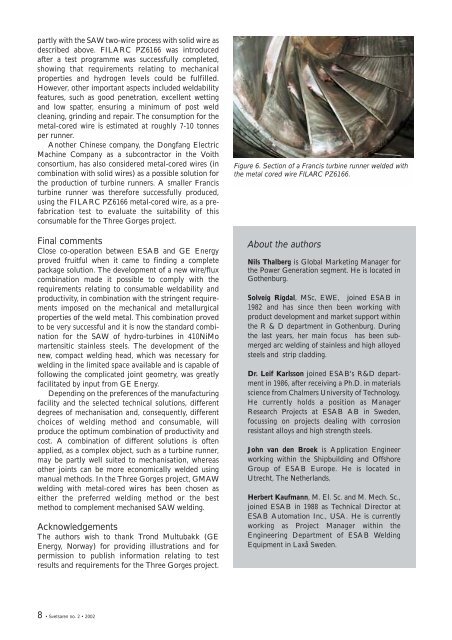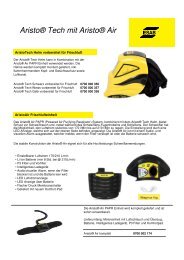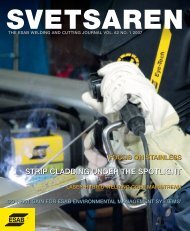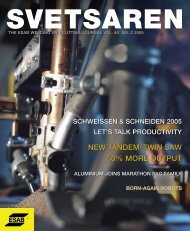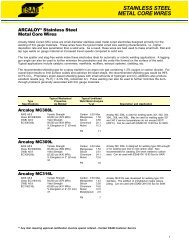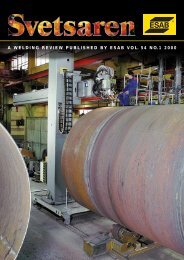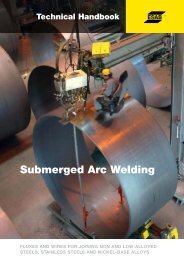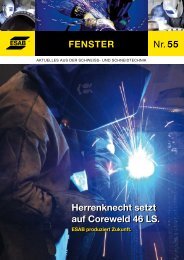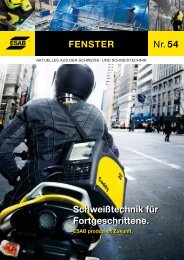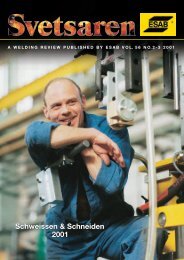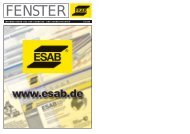Svetsaren_nr2 definitief (Page 1) - Esab
Svetsaren_nr2 definitief (Page 1) - Esab
Svetsaren_nr2 definitief (Page 1) - Esab
You also want an ePaper? Increase the reach of your titles
YUMPU automatically turns print PDFs into web optimized ePapers that Google loves.
partly with the SAW two-wire process with solid wire as<br />
described above. FILARC PZ6166 was introduced<br />
after a test programme was successfully completed,<br />
showing that requirements relating to mechanical<br />
properties and hydrogen levels could be fulfilled.<br />
However, other important aspects included weldability<br />
features, such as good penetration, excellent wetting<br />
and low spatter, ensuring a minimum of post weld<br />
cleaning, grinding and repair. The consumption for the<br />
metal-cored wire is estimated at roughly 7-10 tonnes<br />
per runner.<br />
Another Chinese company, the Dongfang Electric<br />
Machine Company as a subcontractor in the Voith<br />
consortium, has also considered metal-cored wires (in<br />
combination with solid wires) as a possible solution for<br />
the production of turbine runners. A smaller Francis<br />
turbine runner was therefore successfully produced,<br />
using the FILARC PZ6166 metal-cored wire, as a prefabrication<br />
test to evaluate the suitability of this<br />
consumable for the Three Gorges project.<br />
Final comments<br />
Close co-operation between ESAB and GE Energy<br />
proved fruitful when it came to finding a complete<br />
package solution. The development of a new wire/flux<br />
combination made it possible to comply with the<br />
requirements relating to consumable weldability and<br />
productivity, in combination with the stringent requirements<br />
imposed on the mechanical and metallurgical<br />
properties of the weld metal. This combination proved<br />
to be very successful and it is now the standard combination<br />
for the SAW of hydro-turbines in 410NiMo<br />
martensitic stainless steels. The development of the<br />
new, compact welding head, which was necessary for<br />
welding in the limited space available and is capable of<br />
following the complicated joint geometry, was greatly<br />
facilitated by input from GE Energy.<br />
Depending on the preferences of the manufacturing<br />
facility and the selected technical solutions, different<br />
degrees of mechanisation and, consequently, different<br />
choices of welding method and consumable, will<br />
produce the optimum combination of productivity and<br />
cost. A combination of different solutions is often<br />
applied, as a complex object, such as a turbine runner,<br />
may be partly well suited to mechanisation, whereas<br />
other joints can be more economically welded using<br />
manual methods. In the Three Gorges project, GMAW<br />
welding with metal-cored wires has been chosen as<br />
either the preferred welding method or the best<br />
method to complement mechanised SAW welding.<br />
Acknowledgements<br />
The authors wish to thank Trond Multubakk (GE<br />
Energy, Norway) for providing illustrations and for<br />
permission to publish information relating to test<br />
results and requirements for the Three Gorges project.<br />
Figure 6. Section of a Francis turbine runner welded with<br />
the metal cored wire FILARC PZ6166.<br />
About the authors<br />
Nils Thalberg is Global Marketing Manager for<br />
the Power Generation segment. He is located in<br />
Gothenburg.<br />
Solveig Rigdal, MSc, EWE, joined ESAB in<br />
1982 and has since then been working with<br />
product development and market support within<br />
the R & D department in Gothenburg. During<br />
the last years, her main focus has been submerged<br />
arc welding of stainless and high alloyed<br />
steels and strip cladding.<br />
Dr. Leif Karlsson joined ESAB's R&D department<br />
in 1986, after receiving a Ph.D. in materials<br />
science from Chalmers University of Technology.<br />
He currently holds a position as Manager<br />
Research Projects at ESAB AB in Sweden,<br />
focussing on projects dealing with corrosion<br />
resistant alloys and high strength steels.<br />
John van den Broek is Application Engineer<br />
working within the Shipbuilding and Offshore<br />
Group of ESAB Europe. He is located in<br />
Utrecht, The Netherlands.<br />
Herbert Kaufmann, M. El. Sc. and M. Mech. Sc.,<br />
joined ESAB in 1988 as Technical Director at<br />
ESAB Automation Inc., USA. He is currently<br />
working as Project Manager within the<br />
Engineering Department of ESAB Welding<br />
Equipment in Laxå Sweden.<br />
8 • <strong>Svetsaren</strong> no. 2 • 2002


